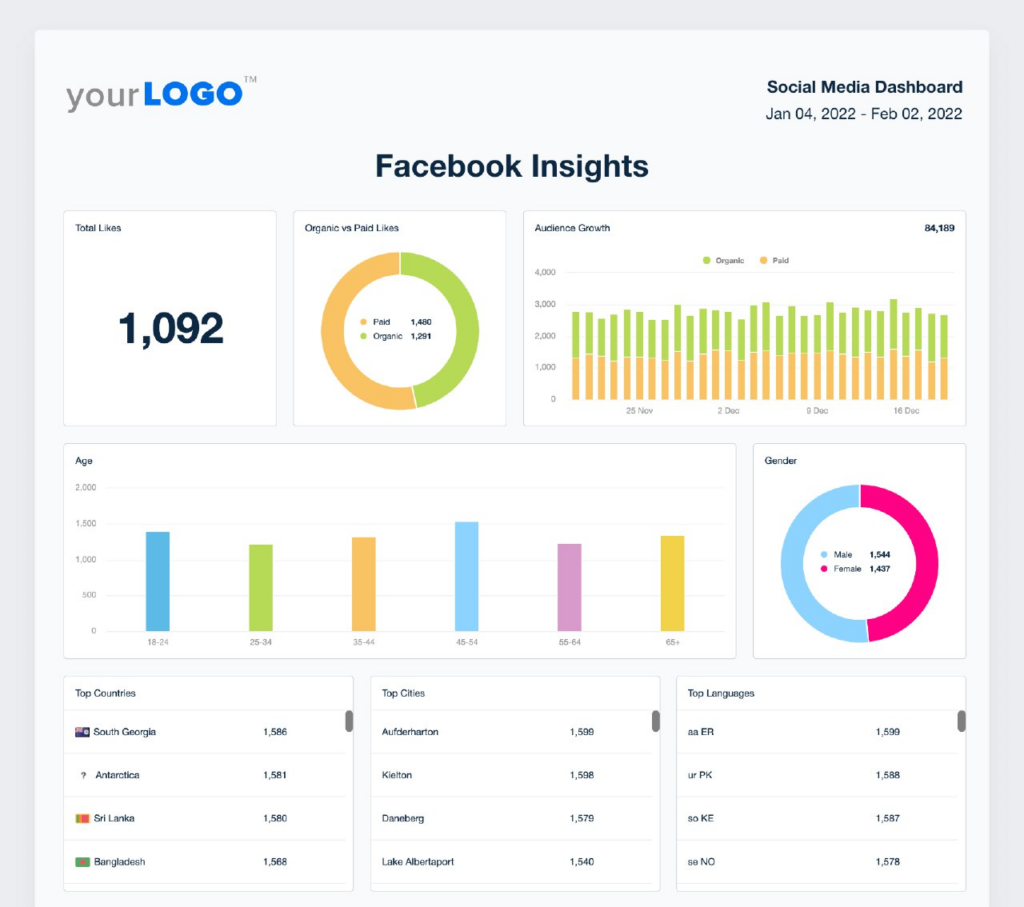The rise of social media since MySpace’s peak in 2004 has been nothing short of exponential, impacting nearly every aspect of modern life. From music to fashion, entertainment, and buying decisions, social media significantly shapes people’s perceptions of things.
In Q4 of 2022, 4.6 billion of the world’s population were active social media users, and as of 2023, records show that 311.3 million US residents were social media users. This figure accounts for at least 90% of the total population in the United States.
As a savvy business owner, you can’t afford to ignore these numbers. Social media is the key to reaching your target audience on a massive scale and expanding your revenue.
In this blog, we’ll explore the world of social media marketing and show you how to harness its power to take your business to new heights. So, let’s dive in!
The Basics of Social Media Marketing
Social media marketing is the use of social platforms like Instagram, Facebook, and Twitter to create awareness about a brand and its product, as well as to engage its audience and ultimately boost sales.
Admittedly, traditional mediums of advertising like print media and referral marketing have been effective. However, in today’s interconnected world, it is only right for businesses to expand and explore modern means of advertisement.
With the increasing number of internet users across demographics, it’s crucial for businesses to leverage this technological advantage to succeed in today’s market.
Social media marketing is a powerful tool for businesses to reach a wider audience of consumers. However, it’s not as simple as posting product pictures on Instagram or creating a trending hashtag on Twitter.
To effectively utilize social media for marketing purposes, businesses must plan, research, develop a strategy, and measure its effectiveness.
The Three Kinds Of Social Media Marketing
Organic Marketing

This is a digital marketing strategy that a brand uses to get people to visit their website without having to pay for ads. Organic marketing targets potential customers by appealing to their sense of community.
Since organic media are non-promotional, the people that are likely to see such posts are a percentage of your followers and their followers, as well as people following whatever hashtags you use.
When an audience naturally gravitates towards your content because they find it entertaining, educational, or relatable, it builds some sort of brand-consumer relationship in their consciousness. This sort of relationship is easy to nurture because it flows naturally.
Organic marketing strategies include, among other things, posts on social media, blog posts, YouTube videos, and guest posts. Most of the time, organic social media content is promoted through Search Engine Optimization (SEO), social media posts, and email campaigns.
Paid Marketing

This form of marketing occurs when brands pay social media sites like Instagram, Facebook, and Twitter to share their content with potential customers on the platforms.
Unlike other types of marketing, paid marketing is precise, as it works to attract a targeted audience on a large scale.
Because of the large scale exposure that comes with paid media, brands are likely to hit their business goals faster compared to other kinds of marketing.
Influencer Marketing, Retargeting, Pay Per Click (PPC), video ads, etc. are types of Paid Marketing.
Earned Media
Earned media is the promotion and attention your brand gains that you didn’t create or pay for. Earned media come in different forms – social media shoutouts, customers’ reviews, shares, product reviews, likes and retweets of your content, recommendations, etc.
In a way, earned media trickles down from organic and paid marketing because it is from them that earned media is gotten.
Earned media is influential, cost-effective and sustainable, especially for small and upcoming brands. Unlike paid media, which requires consistent monetary investment to keep running, earned media does not.
To some extent, earned media is the yardstick by which to measure the effectiveness of a brand’s marketing strategy. After all, it is the extent of exposure that a brand has that determines and drives earned media.
Choosing the Right Media for Your Social Media Content

There is no hard-and-fast rule as to which form of media to use for your social media advertising. This is because organic, paid, and earned media all have their pros and cons.
Organic marketing is an excellent way to connect with potential customers and establish meaningful relationships with them. However, it has limitations in terms of reach. Due to the ranking algorithms of social media platforms, it can be challenging to attract attention to your brand through organic marketing alone.
On the other hand, paid media assures brand visibility—not just by any audience but by people likely to be interested in your products or services. Paid advertising increases your brand’s chance at a good ROI since it targets people based on their interests, demographics, and behaviors.
One major drawback of paid media, however, is that it can be expensive, especially in a competitive market where demands are high.
So which media is best for your business?
Think of these forms as a tripod. Each of them is as important as the other, and they all work together to make a holistic social media marketing campaign. This means that you cannot utilize one in isolation from the others.
The best option, therefore, would be to include all three kinds of media in your social media strategy: free, paid, and earned. You can use paid media to attract new leads, organic media to sustain relationships with existing customers, and earned media to improve your brand engagements.
By leveraging all these forms of media, your brand will cater to every category of audience.
Why Your Competitors Use Social Media Marketing – And You Should Too
It has a Wider Reach
Every business needs customers to thrive, hence the basis of marketing. Even though traditional forms of marketing like newspapers and television are effective, they still fall short. This is because they can be restrictive.
For instance, the reach of newspaper advertisements is not only limited to particular demographics; it has also declined in the wake of the digitalization of the economy.
Also, a brand’s message is not given much expression in traditional marketing mediums like handbills and magazines. While the ideal customers of digital marketing can get access to pages of information by clicking an ad link, the messages of advertisements that are printed or broadcast must be condensed into an area or a period of time.
So it seems that with traditional marketing, you are either sidelining a demographic or not properly influencing their buying decisions.
Social media marketing is unique in that it can reach a diverse range of potential customers simultaneously. Unlike other marketing tools that target specific demographics, social media connects all types of audiences, from busy professionals to Gen Z members, middle-class individuals, and Baby Boomers.
With its hyper-targeted visual content, this form of marketing is sure to draw in anyone with intent at any time. As such, when a brand brings its product to the internet, it is leveraging the largest market available. This increases the chance of marketing success in terms of its reach and effect.
It is Big on Audience Engagement

Social media platforms offer businesses an accessible and efficient way to engage with customers. Brands can now communicate directly with their audience through shoutouts, comments, and DMs. This ease of communication was once a luxury for businesses, as they were limited to phone or in-store interactions with their customers.
This traditional mode of communication was often frustrating for customers who didn’t want to be put on hold or visit a physical location. Social media has changed the game, making it easier for businesses to connect with their audience in real-time.
With social media, brands can now interact with their customers, respond to their posts, share user-generated content, and reach out to unhappy customers.
The effect of this is that customers will feel seen, valued, and appreciated. In fact, a study shows that 47% of customers have a good opinion of brands that respond to customer questions or complaints on social media.
When properly responded to, 71% of consumers have a high tendency to refer the brand to their friends and acquaintances.
Through polls, social media marketing also makes it easier to find out what people think about your products or services. When you put up new content online, customers can give immediate feedback on what they think about it and how you can be better.
Asides from having a platform to engage customers on, social media also brings your customer service close to the people. Not only do you get to keep your customers, you also get to attract others when they see how swift and helpful your customer service is.
It Increases Brands’ Website Traffic
Ideally, when you market your brand on social media, your posts should lead your audience somewhere—preferably your brand’s website. Basically, your posts are an opportunity to drive traffic to your site, so it is advisable that you have backlinks to your website on them.
For social media marketing to be effective, you must hold up your end of the bargain by uploading compelling social media content—something to ignite curiosity and encourage click-throughs.
You can get people interested in your visual content by using a catchy headline or an interesting snippet in your posts. If viewers are hooked enough on your content, then you can direct them to your site by including a CTA (Call to Action) and a link at the end of your post.
Almost every social platform has a spot where you can include a link to your site. For Instagram, you can only add clickable links in your Stories but not your feed posts. On YouTube, this can be done in the video captions and pop-ups. On its part, Twitter comes up with automated link previews when you add a link to your tweets.
As a growing business, leveraging social media groups focused on your industry can greatly increase your website traffic.

Another way that social media marketing helps drive traffic to your website is through social media shares. When viewers are impressed with your content, they are more likely to share it with their network, thereby expanding your brand’s reach. You can also encourage them to share.
Retarget Missed Customers
In online shopping, it is not unusual for prospects or customers to visit your website and add a product to their carts but end up not buying those products, especially when it is their first visit.
On average, businesses record a 65% cart abandonment rate on their shopping apps, and this is about an $18 billion loss in annual sales revenue.
You can, however, encourage a substantial percentage of these missed customers to complete their purchase thanks to sponsored ads. Even if they wouldn’t immediately purchase the product, retargeted ads could help them keep your brand in mind.

More often than not, retargeted ads are effective, and consumers are more likely to return to brand pages.
As opposed to traditional marketing, it is easy to get the data of missed customers when social media is your medium of advertisement. By placing cookies in visitors’ browsers when they visit your website, you can utilize retargeting services on social media platforms like Instagram to display ads to those potential customers.
This helps keep your brand in the minds of your prospects or urge them to complete their purchase, even when they are no longer on your site.
It is Cost Effective
Social media marketing is the one medium where you can market your brand on the largest market and reach a large spectrum of audience members at a relatively low price.

For one, organic social media marketing is mostly free. You can create a social media profile (or use one you already have), make your own visual content, and use your page to promote your brand. You can strategically upload content by creating content on trending topics that are relevant to your brand.
If you would rather pay for advertising instead, there are different platforms to choose from. On Facebook, for instance, the average cost per thousand impressions is around $13. There is a decent chance that you’ll make this back with interest, if a thousand people view your content.
Then there is earned media. This is the free brand promotion you get through social shares, comments, customer reviews, and the likes.
Whether or not you pay for social marketing, the traffic and exposure you gain are worth it.
6 Key Elements of a Successful Social Media Marketing Strategy
There is no one-size-fits-all strategy that every brand can employ. There are, however, some general pointers that all brands should follow, no matter what they sell or do.
Conduct Market Research
Market research is the foundation of any successful marketing strategy. Before you can draw up an effective strategy, you must understand your target audience, their needs, and their preferences.
The first item to cross off this list would be identifying your consumers. Who are they? Are they busy professionals? The home-centric men? Or the nursing mothers? It is important to define your consumers so you can focus your marketing efforts on the groups that are most likely to patronize your brand. Identifying your consumers also helps maintain consistency in your brand tone and message.
After consumer identification, you have to determine what their pain points are. What kind of product or service would improve their quality of life, and how can your business provide this? To effectively cater to the needs of your customers, it is essential to have a deep understanding of their pain points. This insight helps align your products or services as the solution to their problems.
Another important area to research is the social platform that your target audience spends the most time on and the kind of content they engage with most. This is necessary because it is one thing for your marketing campaign to reach an audience, and it is another thing for the campaign to reach your target audience. The more streamlined your social media marketing (SMM) strategy is, the more effective it will be.
Develop a Marketing Strategy

Your social media marketing strategy is your brand’s in-depth game plan on how to reach your prospects and convert them into paying customers through social media campaigns. It guides your business on what actions to take in your marketing journey and also provides metrics by which to measure your progress.
Your marketing strategy should contain your goals for each social media platform that you use and how you aim to achieve them. Each of these goals must be S.M.A.R.T., that is, specific, measurable, attainable, relevant, and time-bound. This also includes the kind of content to be uploaded, which must appeal to your brand’s culture and values.
An effective marketing strategy also needs a social media content calendar. This calendar helps you plan, organize, and track your social media posts. It gives an overview of already-created social media content, organized by the dates of publication.
A social media content calendar saves time and helps organize your processes, as well as ensuring consistency in your social media posts, among other benefits.
Your strategy should also have meaningful metrics that you can use to track your progress. Such metrics could include engagement rate, number of click-throughs, conversion rates, number of views, etc.
Lastly, your marketing plan should include a way for customers to tell you what they think. Apart from the metrics that you set, this is another way to determine the effectiveness of your strategy.
Ultimately, a working marketing strategy is a progressive one. This means that it must be open to being adapted to current trends.
Create and Promote Engaging Content

Now, content plays a crucial role in achieving business media goals like lead generation, brand visibility, audience engagement, etc. For all these to come through, you must work hard to produce sticky content.
Sticky content refers to published content on your site that not only attracts your target audience but also sustains their attention, in that they keep coming back to it.
For content to be that sticky, you need to keep it brief, and straightforward. As a brand marketer or business owner, you should understand that the attention span of the average customer is short, so avoid anything too technical. Besides, it is easier to recall clear and concise information.
Another way to engage your audience with your content is to create interactive posts. To do this, you can’t go wrong with the age-old technique of throwing questions at your audience. Through the use of this call to action (CTA), users are gently prompted to comment, which in turn enhances engagement.
For instance, if you are a food brand, you can ask questions like, “What are the unconventional ingredients that you add to your favorite dish?” You could also put up pictures of different dishes and ask which is their favorite and why.
Brand giveaways are another excellent way to get viewers’ attention. It helps viewers identify your brand and make a mental note of it for when they are ready to make a purchase. It also increases app and website traffic since it requires active participation from the audience.
Track Analytics of Your Social Media Posts

It is not enough to upload social media posts with the aim of marketing; you also have to track the level of engagement that these posts attract. Social media, in whatever context, was never designed to be a one-way experience.
The key metrics to track in social media marketing are the likes, comments, mentions, retweets, and shares of your posts, as well as visits to your profile. These metrics help you measure how much your content resonates with your audience.
By tracking these metrics, you will gain insights into the kind of content that works for your audience, whether infographics, videos, presentations, or images. You will also learn the best time to post to ensure optimum engagement.
Essentially, social media engagement guides you in determining the overall effectiveness of your content marketing strategy and, where necessary, refining it to improve your product or service.
Some of the best social media analytics tools with which to track social media engagement are HubSpot, Hootsuite, and Buffer, among others.
In the long run, when you have better media engagement, you get to build a stronger connection between your customers and brand.
Create Customer Relationship Management (CRM) System

The one advantage that social media marketing has over other forms of advertising is the ease of access that consumers have to businesses – exploit it. Unlike in-store visits and congested phone lines that obtain in other forms, digital marketing allows customers to communicate through DMs, comment sections, shoutouts etc.
This ease of communication not only helps to foster a brand-consumer relationship, but it also makes it easy to achieve customer satisfaction.
To effectively manage the brand-customer relationship, though, you have to adopt a social CRM system. A social CRM connects your social media platforms to your customer relationship management system. This lets you relate to your customers and prospects online.
A social CRM promotes real-time interaction between you and your customers. You can address their questions, complaints, and feedback promptly.
When customers feel that they’re heard and valued, the rate of customer retention increases, and satisfied customers don’t keep quiet about brands.
Social CRM does more than just provide customer service through a customer’s preferred social network. It also tracks sales communication and conversion rates through social media platforms.
Importantly, a social CRM system benefits every team in your business, especially those whose work is tied to customers or leads. Departments such as tech support, customer service, sales, product development, and marketing gain access to customer data, which allows them to make strategic decisions.
Social CRM tools to consider are Sparkcentral, Zendesk, and Sprout Social among others.
Optimize Your Profile

Creating a working social media strategy might not carry you very far if your social media profiles are not optimized. A well-optimized social profile aids brand visibility, drives website traffic, and boosts sales.
When you optimize your brand profile, it is a good step towards ensuring that your target audience sees your posts. And with engaging content, you get to convert them into paying customers.
Profile optimization is how you ensure that your brand profile is easily discoverable on search engines by prospects and existing customers.
One factor that points to the strategic placement of your brand on social media is your profile picture. The usual rule of thumb is to use your brand logo or name, but, of course, this is not rigid. Alternatively, you can use an image that captures your brand story or brand identity.
Another thing to look at is your profile’s bio or description. It is important that you include keywords in your bio and descriptions, as this will aid buyers with intent in finding your profile. An informative bio also helps prospects understand what your business is about and whether or not they should patronize you.
5 Social Media Platforms to Boost Your Marketing Efforts
Social media channels are no longer just ways to talk to people; they have become a digital marketplace. Some of the social media platforms you can use are thus highlighted.
With almost 3 billion monthly users spread across different demographics, Facebook remains the chief social media marketing platform. Of these users, 67.5% visit the platform daily, which amounts to a potential ad reach of 1.56 billion people. It therefore comes as no surprise that Facebook accounts for 71.64% of all web traffic referrals from social media.
As a brand marketer looking to get engagement numbers on your brand profile, leveraging Facebook is a no-brainer.
Apart from the promising global reach that Facebook boasts of, this digital marketing tool also helps with precise targeting by bringing your content not just before any audience, but one likely to patronize your business. Facebook does this by interpreting its algorithms to determine the content that is likely to interest viewers.
Features
- Lookalike Audiences: In the business of ensuring that your brand gets as much visibility as possible, Facebook uses this feature to mirror your already existing custom audience, and create a lookalike audience. It looks at the information about this audience, like their interests, behaviors and demographics, finds people who share these similar qualities and delivers your ads to them as if they were your original target audience.
You can use any percentage range of your original customers to get your lookalike audience, but for a better result, you might want to use a range of your best-performing customers as opposed to all of them.
- Lead Ads: Even though some prospective customers want to know more about your business, they might find it burdensome to fill out forms that come with ads. With Facebook Lead Ads, though, you get to preserve such leads and reduce lead drop offs with customized ads.
As such, when your ad pops up on their screen, they only need to tap on it, and a form comes up – which is already autofilled with their Facebook information. Your customer relationship management system can be synchronized with newly produced leads, allowing your sales team to take prompt action.
- Facebook Pixel: This functions as an analytics tool that helps you measure the effectiveness of your brand’s marketing. It’s a piece of code in your website that tracks the actions that audiences take on your site after viewing your ads. This feature informs you to know whether they take action you desire or they bounce.
With Facebook Pixel, you can also retarget audience members who have visited your site or interacted with it. You can do this by showing ads for products in the visitors’ shopping carts or wish lists.
In all, Facebook Pixel helps you improve your marketing strategy by measuring conversion rate, optimizing your ads, and generating audiences for future advertising.
Instagram stands gallantly behind Facebook as the second-most popular social media tool. Boasting 143.35 million subscribers out of the entire US population, this platform is a must-use for every brand.
As a brand marketer, Instagram is definitely a tool that social media marketers should pay attention to because of the priority it gives to visual content. And if there is anything to know about visual content, it is that it is a powerful marketing tool that has a significant hold on the minds of the audience.
Understanding that a lot of audience members are inclined to picture and video content, Instagram is a sure way to incite audience engagement in your social media marketing.
Features
- Instagram Stories: Brand marketers use this feature to enhance brand visibility and audience engagement. It allows businesses to upload pictures or video content on their profile for 24 hours.
While it might be relatively easy to miss a brand’s post on the traditional feed, consistent IG stories make it possible for your brand to easily catch the attention of followers.
An orange and purple circle appears around your profile picture to alert your audience when you post new content on your story. Viewers can respond to stories with comments, emojis, polls etc.
- Live Rooms: This feature allows brands to tell their stories and shed more light on their identity by holding Q&A sessions with their customers, hosting webinars with experts and talk shows with influencers. If you’re particularly into demonstrative products and services, you can hold tutorials with this feature.
Previously, you could only hold these sessions with one person, which was limiting. Now, Instagram can take up to four people, which means you can have up to three guests in your live room.
- Instagram Polls: This feature works on IG stories, and it boosts engagement with your brand by giving your viewers a chance to interact with your posts and give feedback about your brand and services.
By polling your audience, you can solicit answers from them and get results in real time. With this, you can also find out their expectations from your brand. It is basically a cost-effective way to conduct market research. This will help you make necessary adjustments to your marketing strategy.
Instagram polls are easy to use, visually appealing, and easily adaptable to your story photos and videos.
YouTube
YouTube comes after Google as the second-most visited site in the world, amassing over 22 billion visits per month. Understandably, it is a useful tool for extending your customer base and ultimately driving sales increases.
If your products or services are best advertised through long form content and your consumers are not avid readers, you can always jump on video content. Long-form content is any kind of content that requires more time to read or watch.
While using YouTube for your social media marketing, you should keep in mind that this tool is different from others in the sense that it is not an interactive platform per se. As a result, you will need to use these other (interactive) social channels to drive traffic to your YouTube account. You can do this by sharing snippets of your video content on Instagram, Twitter, or Facebook, then adding a link to continue watching.
Features
- Fan Finder: This feature helps to promote brand awareness by helping you find potential fans and showing them your YouTube video.
To find these fans, YouTube uses its algorithm to determine the viewers that are most likely to be interested in your products or services.
The video appears to the fan as a TrueView ad with an option for them to skip. This pop-up helps to create awareness about your brand and generate leads. This is at no cost to you.
- Captioning: This is the subtitle option that YouTube offers for your videos.
This feature helps increase the reach of your brand marketing by making it accessible to a foreign and hearing-impaired audience. Indeed, a study shows that adding captions to video ads can increase your views by 12%.
YouTube captioning is also an SEO hack that increases your visibility on search engines. The captions add text metadata to your videos, which helps them rank well on search result pages.
- Branding Watermark: You can add your brand image on every of your videos. This brand image can be hyperlinked such that when your viewers click on it, it triggers them to subscribe to your channel from within the video.
Notable for being the largest networking site for professionals, LinkedIn is easily the go-to platform for B2B marketing. Marketers confirm that they get to generate and nurture quality leads on LinkedIn. Because it is a well-known corporate network, it is easy to make connections, build networks, and find leads that are relevant to your business. In addition to lead generation, LinkedIn also provides valuable insights about employers, employees, and job seekers.
Features
- LinkedIn Carousel Ads: This feature helps you create visually engaging content for your viewers by allowing you to create different visual content in a single post.
This helps to convert viewers because it gives a wide overview of what your business is about.
- Hide Connections: While this feature might seem shady, it is really just a privacy protection mechanism.
It helps you hide top-paying clients on your LinkedIn connections, so they don’t get poached by your competitors.
- LinkedIn Showcase Page: This is particularly useful for brands that have subsidiary individual brands.
Showcase Pages let you create some form of extension of your LinkedIn page and tag them as “Affiliated Pages” – under the umbrella account.
LinkedIn Showcase Pages allow brands to be more specific about their content.
Twitter is the perfect social platform for interaction with your customers. Not only are viewers more responsive, but they also spend more time viewing promotional ads when compared to other social networks.
This might be connected to the fact that Twitter has a more engaging interface. Consumers can call out to a brand and have an unrestricted and clear line of communication.

Another attribute that propels conversation on Twitter is the trend table. If you can get your brand name on the trends table or jump on an appropriate hashtag that’s relevant to your business, you can create brand awareness.
Features
- Twitter Threads: This is one advantage that Twitter has over other social platforms, because it allows businesses to educate their audiences through a sectionalised wall of texts.
It allows for long content forms, broken into paragraphs of 280 characters. This paragraph restriction makes it easy for viewers to follow your story without getting bored.
With Twitter threads, you can give additional context to your brand and products.
Twitter threads also encourage audience engagement since they can choose any of your string of tweets and bare their minds.
- Twitter Amplify: This feature markets your brand by placing your ads in the premium video content of publishers who are relevant to your brand, as well as audiences who are likely to be interested in your products.
This feature is of two kinds: Amplify Pre-Roll and Amplify Sponsorships.
Twitter Amplify Pre-Roll uses a list of sectors you’ve chosen and displays your video ad to play as a pre-roll on premium video content across these sectors. Typically, the publishers of this offer a one-to-one Amplify Sponsorship package in which you can collaborate with a top publisher. Premium video content has big names like Adidas.
An exclusive one-to-one Amplify Sponsorship package lets you partner with a prominent publisher. Sponsor events, moments, or programs on Twitter, and we work with our publishing partners to get you the best offer.
- Twitter Spaces: This functions as a virtual chatroom where you can hold audio chats with your Twitter community.
With Twitter Spaces, you can promote a new product and talk with your followers in real time about their thoughts.
You may also choose to host discussions on trending topics in your industry; this helps you achieve an authority status in your niche. What this does for your business in the long run is that you get to strengthen your relationships with your customers or prospects and network with relevant influencers.
FAQs
Facebook is the most commonly used social media platform among brand marketers. This is unsurprising since it has the largest number of active users.
Three factors that must be present in your social content are:
. Personality: Let your audience get to know your brand and what it entails.
. Purpose: Make sure your viewers derive value from your content; something that benefits them.
. Promotion: Only after these two, can you promote your products. This Is to ensure your posts aren’t too sales-y.
The steps to starting your social media marketing agency are these:
. Define your niche
. Determine your services and set your pricing.
. Create a social media marketing plan.
. Build your clientele.
. Create and nurture brand social media presence and a strong portfolio.
. Join communities relevant to social media marketing.
You may post promotional content three times weekly because too many sales-y posts can be bothersome to your followers. Endeavor to connect via jokes, information pieces, memes, and any other form of content that does not directly sell.
As a brand, these posts must not find their way to your profile:
. Controversial content.
. Content that are inconsistent with your brand identity.
. Content with unverified information.
. Overly promotional content.
. Derogatory content.
Parting Thoughts
Every Tom, Dick, and Harry is aware that the internet has become a digital marketplace. In the history of brand marketing, there has not been a marketing medium that boasts of such a wide audience reach as social media.
As a brand looking to generate leads and engage its audience, it only makes sense to leverage this marketing medium.
There are certain guidelines to follow, though. It is only by understanding and adhering to them that you can properly leverage social media marketing.













